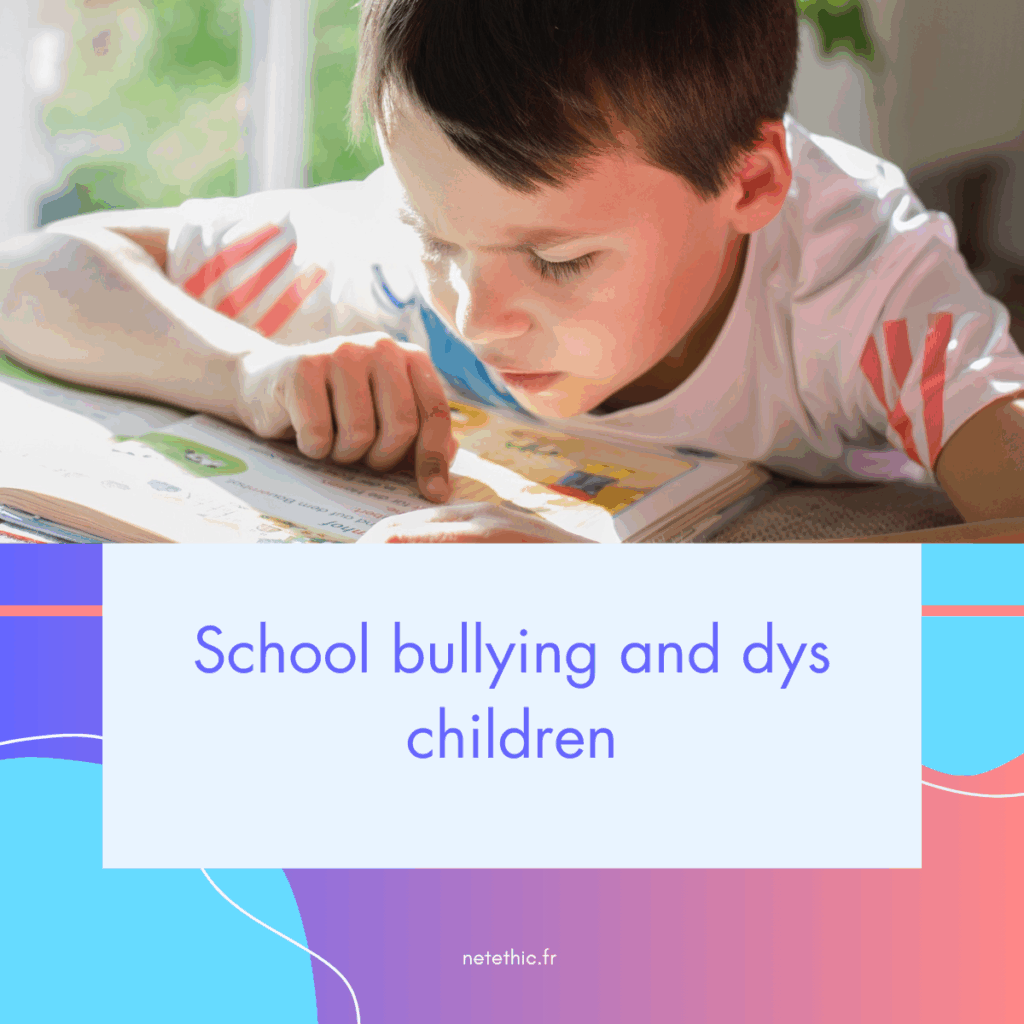School bullying and dys children: how to identify, understand, and take action to protect them
School bullying has become a major issue in educational settings today, and statistics show that it affects a growing number of children. Among the victims, students with ‘dys’ disorders—dyslexia, dyspraxia, dysphasia, dyscalculia, ADHD, or other neurodevelopmental conditions—are particularly at risk. Their differences, often misunderstood or misinterpreted by peers, unfortunately become frequent reasons for mockery, exclusion, or repeated aggression. To better protect these vulnerable children, it is essential to recognize the mechanisms of bullying, understand the warning signs, and take appropriate action as soon as any concern arises.

Why are dys children more often victims of bullying?
Even though school bullying concerns about 5% of students, studies show that nearly 60% of victims present a neurodevelopmental disorder. This overexposure is not accidental: it is directly linked to the daily challenges dys children face, whether in their learning, their social interactions, or their emotional regulation.
Dys children may be perceived as different because they learn differently, take longer to respond, have less legible handwriting, particular pronunciation, clumsy motor skills, or difficulties with organization. These characteristics draw attention and, within a school environment, difference quickly becomes a pretext to stigmatize, isolate, or harm the child. Fatigue, emotional hypersensitivity, and reduced self-confidence—often already present—further increase the risk of becoming a target.
Identifying school bullying in a dys child: signs, behaviors, and indicators
Conflicts between students are part of everyday school life. But when violence becomes repeated, when a power imbalance sets in, and a child is isolated despite attempts to fit in, it is no longer just harmless squabbling: it is genuine bullying.
Definition of bullying: what should raise concern
According to the specialist psychologist Dan Olweus, bullying is characterized by repeated negative acts, whether physical (hitting, pushing, humiliating gestures), verbal (insults, threats, mockery), or non-verbal (contemptuous looks, grimaces, exclusion). Three criteria should raise concern:
The repetition of the aggressions, which take place over time.
The imbalance of power, which prevents the victim from defending themselves.
The child’s isolation, being targeted because they appear more vulnerable than others.
To this, we must now add a modern and particularly destructive form: cyberbullying, which extends the aggression into the digital space and leaves the victim with no respite.
Common forms of discrimination against children with "dys" disorders
For children with “dys” disorders, the reasons are unfortunately numerous: dyslexia that slows reading, dyspraxia that makes movements awkward, dysphasia that affects pronunciation, ADHD that causes impulsivity or restlessness… anything can become a target for mockery.
Typical forms of bullying include:
Insults, derogatory nicknames, repeated teasing;
Spreading rumors or humiliating comments;
Inappropriate gestures, shoving, or physical violence;
Extortion, theft, or damage to personal belongings;
Deliberate exclusion from activities or groups.
Cyberbullying, on the other hand, can take the form of photo manipulation, account impersonation, sharing humiliating messages, or targeting conversations in private groups.
The bullying system: a group phenomenon
Contrary to popular belief, the bully is not always a “violent” or “difficult” child. Bullying relies on a group dynamic, usually involving an instigator, followers who laugh, encourage, or amplify the attacks, and passive bystanders who do not dare to intervene. Some students defend the victim, but they remain in the minority.
This complex organization explains why addressing bullying is difficult: each participant plays a role, sometimes without even realizing it. A child who repeats a nickname heard in the playground can, unintentionally, amplify the violence. This is why a comprehensive educational approach is essential.
Psychological consequences: anxiety, intense stress, and loss of self-esteem
Under the pressure of daily bullying, the child gradually develops intense stress. They may experience:
Sleep disturbances,
Headaches,
Nausea,
Marked irritability,
Gradual withdrawal from activities they once enjoyed.
When this situation persists, the risk of depression increases significantly. The child loses interest in hobbies, becomes withdrawn, isolates themselves, and may even develop self-deprecating thoughts.
Academic consequences: declining performance, school disengagement, and school phobia
Repeated attacks prevent the child from concentrating in class. Many eventually begin to fear school, invent physical excuses to stay home, or refuse to attend altogether. Absences accumulate, grades drop, and a vicious cycle sets in. Yet, many adults attribute these difficulties to the child’s dys disorder, without realizing that bullying may be the hidden cause.
Social consequences: isolation, dependency, or perpetuation of violence
Bullying profoundly affects a child’s relationship with others. Some children withdraw completely, unable to trust anyone. Others submit to domination in the hope of being accepted. Some may even end up reproducing the violence toward a smaller or more vulnerable peer as a way of asserting themselves.
In the most severe cases, the distress can become so intense that the child’s safety is at risk. This highlights the importance of prompt and coordinated intervention.
How to prevent and respond to bullying of children with "dys" disorders
Take warning signs seriously, even if they seem minor
It is essential never to downplay a child’s words. Phrases like “ignore them” or “it’s not a big deal” trivialize the violence and push the child into silence. Any change in behavior should raise concern: sadness, irritability, damaged belongings, withdrawal, or refusal to go to school.
Protecting children with "dys" disorders: an essential collective commitment
School bullying is neither trivial nor a rite of passage. It is a profound form of violence that can have lasting effects on children, particularly those with “dys” disorders. Protecting them requires a collective effort: parents, teachers, educators, psychologists, and students must act together.
Understanding the mechanisms of bullying, recognizing warning signs, and intervening at the earliest signs not only protects the victim but also helps prevent the escalation of violence within the school community. Children with “dys” disorders, being more vulnerable, require heightened vigilance and tailored support to thrive in an environment where their differences are valued rather than stigmatized.